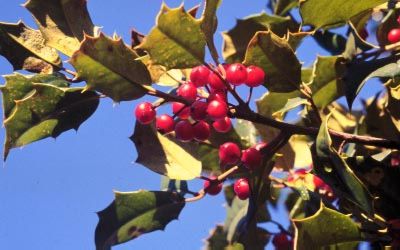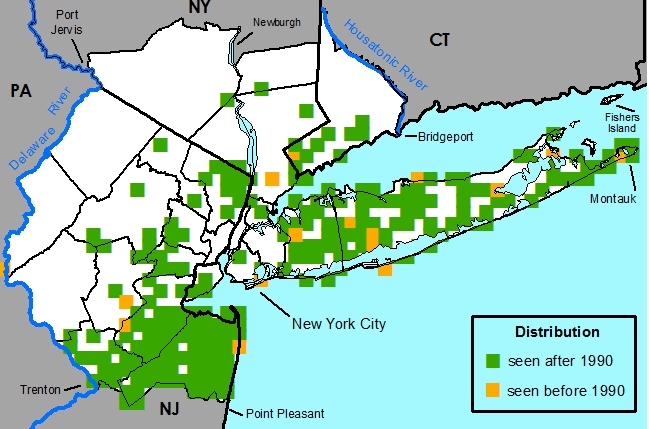Ilex opaca Ait. - American Holly,Evergreen Holly
Common Names
American Holly,Evergreen HollyField Identification
Evergreen shrub or small tree to 15 m with alternate, simple, spiny-margined leaves and with red fruit on female specimens.Medicinal uses
Disclaimer: The information provided here is for reference and historical use. We do not recommend nor do we condone the use of this species for medicinal purposes without first consulting a physician.
Native Americans used various parts for treatment of sore eyes, skin sores, itchy skin, measles, colic, dyspepsia, and muscle cramps. Some Native American women wore sprigs of holly during childbirth, believing that it eased their pain.
Other uses
Widely used as an ornamental with over 1000 cultivars.
The wood is used for cabinet making, tool handles, inlaying, and often for the black keys on pianos.
Native Americans used the wood for cooking utensils and decorative carving; the berries to make a dye. They also used the preserved berries as decorative buttons and often painted or embroidered sprays on their shields and jackets as a coat of arms.
Native Americans also planted holly about their homes as "protectors", used to ward off evil spirits.
The use of holly for Christmas decorations is difficult to trace but is probably a custom adopted from the Romans.
Poisonous properties
Ilex fruit and leaves contain an array of potential toxins which can cause moderate to severe nausea, vomiting, diarrhea, and rarely narcosis. Death is unlikely.
Stories
American Holly is the state tree of Delaware.
Nomenclature
Ilex opaca Ait., Hort. Kew. ed. I. i. 169. 1789.¤Ilex aquifolium sensu Marshall, Arbust. Amer. 63. 1785, not Linnaeus 1753.
¤Ilex laxiflora Lam., Encycl. 3: 147. 1789.
¤Ilex americana Lam., J. Hist. Nat. Paris 1: 416. 1792.
¤Ilex quercifolia Meerb., Pl. Select. Icon. Pict. p. [2], t. 5. 1798.
*Ageria opaca Raf., Sylva Tellur. 47. 1838.
¤Ilex opaca var. laxiflora Nutt., Gen. N. Amer. Pl. 1: 109. 1818. (I. 1. Lamark est pl.
masc.?)
TYPE: unknown
*Ilex opaca f. subintegra Weath., Rhodora, 23: 119. 1921.
TYPE: United States, Massachusetts, Mashpee: 16 February, 1921, L. C. Jones s.n. (Holotype: GH).
¤Ilex opaca f. xanthocarpa Rehder, Mitt. Deutsch. Dendrol. Ges. 1907(16): 73. 1907.
¤Ilex aquifolium baccis flavis Walter, Fl. Carol. 211. 1788.
¤Ilex laxiflora Pursh, Fl. Amer. Sept. 1: 117. 1814.
¤Ilex (opaca) laxiflora Loudon, Arbor. Frutic. Brit. 2: 517. 1838. (p. p. quoad syn. Walter; not Lamark 1789.?)
TYPE: unknown
Description
HABIT Perennial, evergreen, phanerophytic tree or shrub, diclinous and dioecious, 1-15 m tall.STEMS Main stems erect, gray, round. Bark smooth, gray, not exfoliating. Branches ascending or horizontal. Twigs light brown or gray, terete, 2-4 mm in diam., smooth, glabrous or with short and unbranched, erect, light brown or gray hairs, sparse or moderately dense, distributed throughout, eglandular. Pith white, round, continuous; nodal diaphragm absent. Sap translucent.
BUDS Terminal and axillary, monomorphic, scattered along stem; 2-3 mm long; axillary buds 1 per axil, 1.5-2 mm long, scales imbricate, with short and unbranched hairs, eglandular. Leaf scars crescent-shaped, 1-3 mm high, 1-3 mm wide, bundle-traces 1. Twig scars superposed.
LEAVES Alternate, simple, spiral, 1 per node, spaced somewhat evenly along and divergent from stem. Stipules present, minute, lateral, deciduous, free from the petiole, scale-like, margins entire, caduceus, dropping shortly after buds open. Leaves petiolate, petiole terete, 0.4-0.8 cm long, with short and unbranched erect hairs, moderately dense, distributed throughout. Not glabrescent, eglandular. Leaf blades: abaxial surface light greenish yellow, adaxial surface green or dark green, elliptic, bilaterally symmetric, (2.5)3-10(13) cm long, 2 -4 cm wide, coriaceous, base acute, margin spinulose, apex acuminate or acute, abaxial surface glabrous or with short and unbranched erect, white hairs, sparsely distributed along midveins. Adaxial surface glabrous. Venation semicraspedodromous. NOTE: f. subintegra has subentire to entire leaf margins.
INFLORESCENCES Unisexual, simple or compound, raceme, axillary, borne on the new year's growth. Peduncle 0.4- 0.8 cm long. Pedicel 0.4-0.8 mm long, glabrous or with short and unbranched erect white hairs, moderately dense, distributed throughout, eglandular.
FEMALE FLOWERS Cauliferous, with sepals and petals readily distinguishable from one another, 4-merous, 4 mm long, 4 mm wide, fragrance absent. Calyx actinomorphic, persistent, abaxial and adaxial surfaces light yellowish green, 1.5 mm long, margin ciliate, apex acute. Corolla actinomorphic, of free petals 4 mm long, deciduous, abaxial and adaxial surfaces light yellowish green or white, margins entire, abaxial surface glabrous. Gynoecium syncarpous. Carpels 4-9. Style and stigma 1, stigma capitate. Ovary superior, glabrous. Placentation axile. Androecium abortive, reduced and sterile. Flowers usually functional for three to four days.
MALE FLOWERS Simple or compound, cyme or fascicle, axillary. Peduncle present. Pedicel 3-5 mm long, glabrous or with short and unbranched hairs, eglandular. Male flowers 3-4 mm long. Calyx actinomorphic, persistent, abaxial and adaxial surfaces light greenish yellow, triangular, 1 mm long, margin ciliate, apex acute, glabrous, eglandular. Corolla actinomorphic, deciduous, abaxial and adaxial surfaces light greenish yellow or white. Petals 4, 3 mm long, margins entire, apex obtuse, glabrous, eglandular. Stamens 4, yellow. Anthers dorsifixed, opening along the long axis. Filaments free, glabrous, eglandular. Gynoecium vestigial, abortive, rudimentary. Flowers usually functional for only one day.
FRUITS Drupe, red or dark red, globose, 6-10 mm long, 6-10 mm wide, glabrous. Fruits borne singly, one to a pedicel or occasionally 1-3 on a peduncle. NOTE: f. xanthocarpa and cultivars selected from it have yellow to orange fruit, and some cultivated varieties have larger fruit.
SEEDS Light yellow, lanceolate oval to oval in outline; trigonal in cross section, 6 mm long, 3 mm wide eglandular. NOTE: Some seeds up to 13 mm in length in ellipsoid fruits of cultivated varieties.
Habitat
Dry to moist woods, usually in well-drained, acidic soil; also sandy barrier islands.
Distribution
Native to the eastern United States.United States -- AL, AR, CT, DE, FL, GA, IL, IN?, KY, LA, MA, MD, ME, MO, MS, NC, NH?, NJ, NY, OH, PA, RI, SC, TN, TX, VA, VT?, WV
New York Metropolitan Region -- Native, mostly along the coastal plain.
Rarity Status
Heritage global rank -- G5Connecticut -- Not Listed
New Jersey -- Not Listed
New York -- Not Listed
Species Biology
Flowering May [week 4] - June [week 4]Pollination
Mellittophily -- Bee genera in the families Andrenidae, Halictidae, Collectidae: Andrena, Augochlora, Augochlorella, Bombus, Dialictus, Euylaeus.
Cantharophily -- Beetles in the families Cerambyridae, Elateridae, and Mordellidae.
Fruiting July [week 4] - following Spring
Dispersal
Carr, 1990 Carr, 1992 Ridley, 1930 Martin, 1951
Endozoochory-- Avian frugivores: Bombycilla cerorum (Cedar Waxwing), Cardinalis cardinalis (Cardinal), Catharus guttatus (Hermit Thrush), Catharus minimus (Gray-cheeked Thrush), Catharus ustulata (Olive-backed Thrush), Corvus vulgaris (Crow), Melanerpes carolinus (Red-bellied Woodpecker), Mimus polyglottos (Northern Mockingbird), Sphyrapicus varius (Yellow-bellied Sapsucker), Turdus migratorius (Robin), Bonasa umbellus (Ruffled Grouse), Sialia sialis (Eastern Bluebird), Dumetella carolinensis (Catbird), Colaptes auratus (Yellow-shafted Flicker), Sayornis phoebe (Eastern Phoebe), Zonotrichia albicollis (White-throated Sparrow), Hylocichla mustelina (Wood Thrush), Pipilo erythrophthalmus (Towhee), Vireo griseus (White-eyed Vireo), Dryocopus pileatus (Pileated Woodpecker)
Mammals: Sciurus carolinensis? (Eastern Gray Squirrel)("rarely took fruits and were not effective dispersers", Procyon lotor?(Raccoon), Peromyscus spp.?(White-footed Mice)
Germination
Schopmeyer, 1974 Ives, 1923 Barton, 1947 Dirr, 1987
In nature, holly seeds usually germinate from 1-3 years after dispersal, and natural regeneration commonly is sparse. The seeds have hard seed coats and immature embryos; as a rule they are difficult to germinate. Germination is epigeous. Untreated seeds planted in fall: after 1st spring- no seedlings; 2nd spring some seedlings; 3rd spring most seedlings; seasonal distribution of rainfall important for natural germination. Ratio of germination under favorable conditions in nature - 1:1,000,000.

